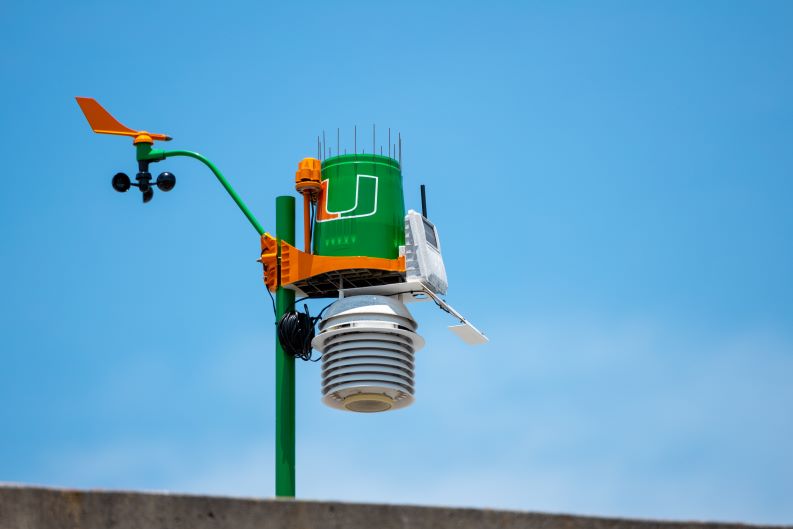Smartphone apps have put the forecast right at our fingertips, but the information we receive from national weather applications don’t necessarily show, with pinpoint accuracy, what is happening on the University of Miami’s three campuses.
“When you think about the climate in South Florida, which tends to be unpredictable, getting a reading from a weather station two miles away can be all the difference between sunshine and thunderstorms,” said Matthew Shpiner, director of emergency management for the University.
Those discrepancies might not matter for mild weather, but when different parts of Florida are facing threats of major thunderstorms, tropical cyclones, hurricanes, and evacuations, getting accurate and complete information is crucial for the University community.
That’s why the University’s Office of Emergency Management relies on the information provided by the four active orange and green WeatherSTEM stations on the University's campuses that continuously monitor, record, and publish real-time weather updates to a dedicated website, mobile application, Twitter, and Facebook page. Two units are on the Coral Gables campus, and one each on the medical and marine campuses.
“The WeatherSTEM units are weather stations comprised of state-of-the-art technology that feed real-time hyperlocal information from a sky-view ultra high resolution cloud camera to a user-friendly web dashboard,” Shpiner said.
The information from the weather stations can be used to help make programing and other decisions, such as canceling an on-campus event during inclement weather.
Most importantly, the WeatherSTEM units “provide a unique level of information that alert us when hazardous conditions threaten our campuses, so that we can effectively communicate it to the University Community,” Shpiner said.
“The system collects information at a frequency of once per minute on the local temperature, dew point temperature, wind speed, wind direction, humidity, solar radiation, ultraviolet radiation, rainfall accumulation, rainfall intensity, barometric pressure, wind chill, heat index, and wet bulb globe temperature,” added Ed Mansouri, CEO and founder of WeatherSTEM.
“Wet bulb globe temperature is especially important in South Florida because it is an effective metric for assessing the risk of heat stress on the human body,” Mansouri explained.
Some sites also have sensors that make measurements of ground conditions in addition to weather conditions.
“For instance, the system at the Hecht Athletic Center (on the Coral Gables campus) also has sensors that measure ground-level temperature and soil conditions which can be useful athletics data points,” said Mansouri.
The information gathered from the stations goes beyond weather measurements and is used for a multitude of purposes, including situational awareness, gathering data used in scientific research, athletics, and in social and civic engagement
In addition, the WeatherSTEM site offers all Floridians a free educational component that includes lesson on weather, solar energy, atmospheric, oceanic, and agricultural subjects.
Mansouri also shared that a new enhancement called DataStream, which provides “weather data from the stations to the web and mobile app literally every second,” is soon to be installed on the medical campus.
“These enhancements work with the aid of an amazing little piece of technology called Raspberry Pi, which is a $30 Linux computer that is the size of a credit card,” he added.
The technology behind the WeatherSTEM stations is continuously improving. By the end of 2020, there will be 50 new WeatherStem units installed across that State of Florida that are solar powered, cellular, and rated to withstand winds up to 185 mph.
“We hope to use this experience to gain new knowledge that can lend itself to further enhancing and modernizing the systems that are on the University of Miami campus,” said Mansouri.
